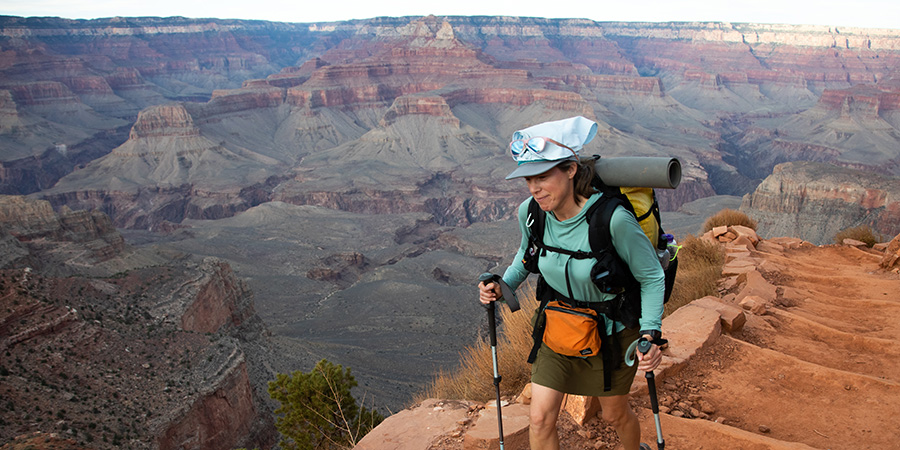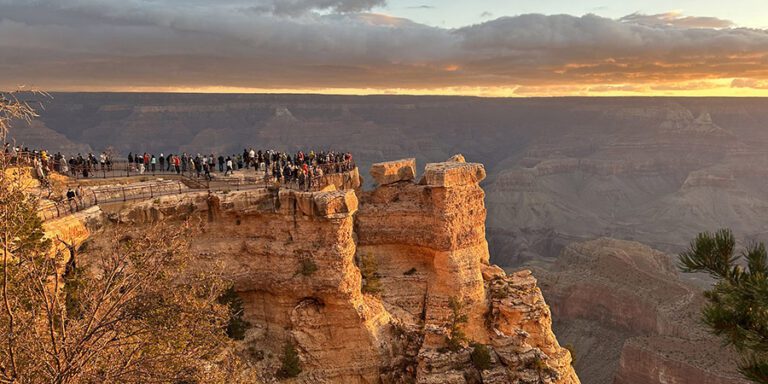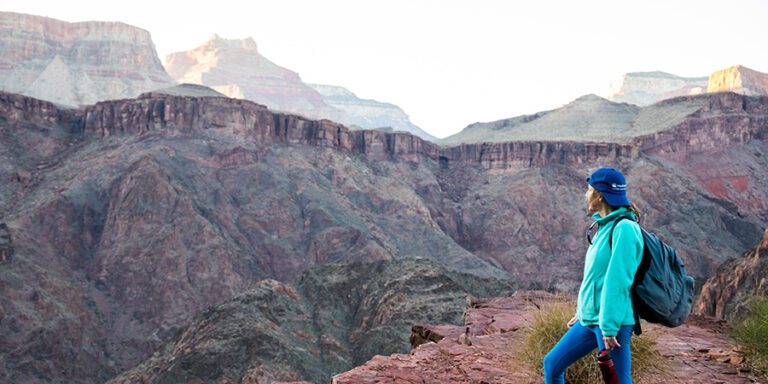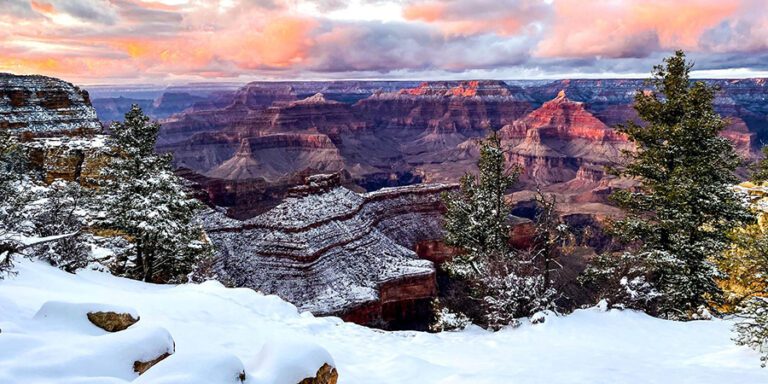
Wondering how to get a permit to hike and camp in Grand Canyon National Park? Let’s break it down.
Navigating backcountry permits can be a headache, especially if that little slip of paper is the only thing standing between you and the hiking trip of your dreams. At Grand Canyon National Park, thousands vie for the chance to spend a night below the rim. With a little know-how and a little luck, you can hit the trail with permit in hand.
General tips:
- Plan in advance — the earlier you try to get a permit, the better your odds.
- Be flexible — your chances of getting a permit improve if you’re willing to adjust your date range and desired campsites based on what’s available.
- Be realistic about mileage and honest about your ability — hiking in the Grand Canyon is its own beast. Ten miles on paper is very different from 10 miles on hot, dry, and steep terrain. If you haven’t hiked in the desert before, tend toward a conservative itinerary.
The basics
Camping anywhere below the rim in Grand Canyon National Park requires a backcountry permit. You can purchase one online as early as four months before the start of your desired trip.
The latest you can reserve a permit through the online system is five days out. After that, you’ll have to visit the park’s backcountry office in person to see if there are any last-minute permits available.
How much lead time you have before your trip and the route you want to hike will determine your options for getting a Grand Canyon backpacking permit.
Four months before your Grand Canyon trip: Apply to the “early access lottery”
Your best chance of getting a Grand Canyon backpacking permit is through the early access lottery system, which awards up to 750 people each month a timeslot to peruse available campsites, select itineraries, and pay for their reservations.
How it works: For two weeks each month, from the 16th to the 1st, recreation.gov accepts lottery applications for hikes beginning four months later. For example, if you want to backpack in the Grand Canyon in October, you can apply for the lottery between May 16 and June 1.
Hint: To back-calculate this, start with the month you want to backpack in the Grand Canyon (October). Jump back four months (June) and subtract two weeks (May 16).
If you are one of the lucky people to be selected from your lottery, you’ll be assigned a day and time to log on to recreation.gov to make your reservation.
A few important notes:
- Lottery selection does not guarantee you’ll be able to reserve the itinerary you want.
- The online permit system is geared toward first-time or second-time Grand Canyon backpackers. Areas outside of the Bright Angel, South Kaibab, North Kaibab, and Tonto trails require ranger clearance to complete your reservation. If this applies to you, and you are a lottery winner, call the Grand Canyon backcountry office during your designated timeslot.
Three months or less before your Grand Canyon trip: Check online for available permits
If you missed the lottery, not all is lost. There may be leftover campsites after each month’s lottery ends. Head over to recreation.gov or call the backcountry office to check the remaining availability three months or less from your desired trip month.
Ex: For an October Grand Canyon trip, reservations open to the public starting in July.
The most popular places to camp in the Grand Canyon are Havasupai Gardens, Bright Angel Campground, and Cottonwood Campground, which sit along the park’s primary rim-to-rim route. Permits for these campgrounds may be hard to snag during peak season (spring and fall), whether you get early access through the lottery or not.
Experienced Grand Canyon hikers: Call or email the backcountry office
Grand Canyon National Park is divided into nearly 100 different backcountry zones, and only the most trodden are available to reserve through the online permit system. If you are an experienced Grand Canyon hiker looking at itineraries outside of the Bright Angel, South Kaibab, North Kaibab, and Tonto trails, call the backcountry office at 928-638-7875, or send an email to grca_bic@nps.gov to work with a ranger to reserve a permit.
For a full list of what you can reserve online, see the park’s website
If last-minute is more your style
Let’s face it. Not all of us are planners. You’ve got a free weekend and are rearing to go. Here’s what you can do.
Try your luck, and show up at the park’s backcountry office.
Cancellations happen. And occasionally, permits are still available (for example, it’s June, and everyone else has the good sense to stay out of the canyon). It’s always worth checking with the backcountry office before resigning yourself to day-hiking. You might not get your dream permit, but hey, a permit is better than no permit at all.
Get on the waitlist
The park reserves a small number of walk-in permits for Havasupai Gardens and Cottonwood Campground, issued daily to people who show up at the backcountry office. These permits are for one or two consecutive nights and can only be purchased the day prior to starting your hike.
How it works: You show up at the backcountry office — no permits available. A park ranger gives you a waitlist number. The next morning, at 8:00 am, you return to the backcountry office, where the ranger issues permits starting with #1 until they are all gone. If the ranger doesn’t call your number before they run out, you can get a new (lower) number for the next day. Repeat this process for as many days as it takes, or as many days as you have, to get a permit.
If all else fails, day hike!
Just because you can’t swing a permit doesn’t mean you can’t experience the canyon. Check out some of our favorite day hikes
Tips for navigating available Grand Canyon backcountry permits on recreation.gov
The Grand Canyon online permit system isn’t the most intuitive, but knowing these terms and tips should help you:
Site or Zone — Grand Canyon National Park is divided into backcountry zones. Each has a three letter/number identifier (see map) that you’ll need to reference in the online permit system to select your desired camping location each night of your permit.
- Campgrounds: There are three — Havasupai Gardens (CIG), Bright Angel Campground (CBG), and Cottonwood Campground (CCG). These have toilets, water spigots, picnic tables, food storage, and ranger stations. They are the most popular places to camp overnight.
- Campsites: Designated campsites in the canyon and on the north and south rims usually have flat places to pitch your tent. Many have pit toilets, and some are near natural water sources (treatment required).
- At-large camping: These remote areas have no facilities. Water sources are scarce. Recommended for highly experienced Grand Canyon hikers with route-finding ability.
Before you log on to recreation.gov, you’ll want to select your desired route, calculate daily hiking mileages, and determine nightly campsites or at-large camping zones. Need ideas? Check out our favorite Grand Canyon backpacking trips
Area — When checking permit availability, you must select a “starting area.” This populates the grid with campsites, campgrounds, or at large camping zones.
- Classic GC Hike – via South Rim: Select this category to book nights at Bright Angel Campground and Havasupai Gardens.
- Classic GC Hike – via North Rim: Choose this category to book nights at Cottonwood Campground.
- Requires Prev GC Experience: Start here if you’ve completed a few Grand Canyon backpacking trips and are planning a route that includes the Tonto, Hermit, or Grandview trails.
- Requires Adv GC Experience: Select this option if you have extensive, below-rim overnight backpacking experience to see the full list of remote use areas.
- Above Rim Areas: Choose this category to reserve sites on the North and South rims.
After you select your first night, the grid populates with pre-approved options for each proximate night. If the campsite you’re looking for doesn’t show up, call the backcountry office.
Numbers and letters in the grid
The grid populates with numbers or the letter “w.”
- A number greater than or equal to one indicates that space is available for you to book immediately.
- Zero means there is no availability.
- A “w” means “walkup” or “wild space” is available. Call a ranger to complete your reservation.
Permit fine print (IMPORTANT!)
If you get a Grand Canyon backcountry permit, log on to recreation.gov at least three days before your trip to print your permit. If you don’t, your reservation will be automatically cancelled.
Frequently asked questions:
How much does a permit cost?
Permit costs include a fixed rate, plus an additional per person per day charge. Check the park website for current prices ›
How many people can be on a permit?
Up to 11. While smaller groups have a better shot at getting a permit, most areas in the park will accommodate groups of up to 11. There are a handful of use areas that won’t take a group that big, so call the backcountry office ahead of time to ask.
What’s the season?
Year-round, although the weather is best in the spring and fall. The road to the North Rim (Highway 67) is closed during the winter, but you can still access the North Rim by hiking across the canyon, or cross-country skiing or snowshoeing in from Jacob Lake.
Do I need a permit for a rim-to-rim?
If it’s you and a couple friends, no. But if you’ve advertised or had people register for the event, you’ll need a special use permit




